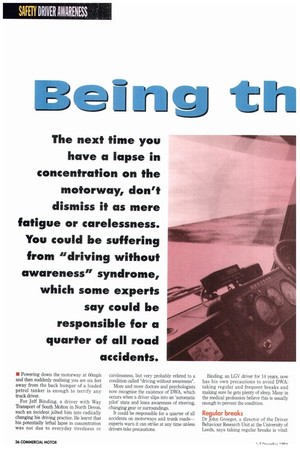Behr]
Page 38

Page 39

Page 40

If you've noticed an error in this article please click here to report it so we can fix it.
• Powering down the motorway at 60mph and then suddenly realising you are six feet away from the back bumper of a loaded petrol tanker is enough to terrify any truck driver.
For Jeff Binding, a driver with Way Transport of South Molton in North Devon, such an incident jolted him into radically changing his driving practice. He learnt that his potentially lethal lapse in concentration was not due to everyday tiredness or carelessness, but very probably related to a condition called "driving without awareness".
More and more doctors and psychologists now recognise the existence of DWA, which occurs when a driver slips into an 'automatic pilot' state and loses awareness of steering, changing gear or surroundings.
It could be responsible for a quarter of all accidents on motorways and trunk roads— experts warn it can strike at any time unless drivers take precautions Binding, an WV driver for 14 years, now has his own precautions to avoid DWA: taking regular and frequent breaks and making sure he gets plenty of sleep. Many in the medical profession believe this is usually enough to prevent the condition.
Regular breaks
Dr John Groeger, a director of the Driver Behaviour Research Unit at the University of Leeds, says taking regular breaks is vital:
"Not only does it give you a rest, but it gives you something else to look at and think about. The brain is healthier if you give it something interesting to look at," he says. "DWA is likely to take hold after very prolonged periods of concentration which are needed for long-distance truck driving. And it is particularly likely on motorways at night when there is relatively little traffic about so the driver doesn't need to respond to anything. The driver gets locked into a Ili'
particular way of looking at the road and his mind begins to wander because he is not having to do anything with the information he is taking in. So that when the driver does have to do something, his mind is elsewhere. If you are particularly tired you have to make a bigger effort to concentrate."
But other experts believe DWA has nothing to do with fatigue. Dr Denver Daniels. a lecturer in psychology at Exeter University, says that even a good sleep the night before will not necessarily fend off DWA.
During research Denver found that truck drivers are most prone to DWA on regular runs. "I found that you get situations where a driver on a regular morning run say would know at a certain point on the motorway to get into the second lane to avoid an influx of traffic going to work. And then when doing the same route at say 2.00am he would automatically get into the second lane at the same part of the road, even though there was no traffic on it,"
Government grant
Daniels had hoped to get a £330,000 Government grant to spend three years researching his theory, with a view to developing an in-cab device to stop drivers getting DWA (CM1-7 September). But he has been told that his planned project, in association with Devon County Council, would have been too expensive.
He is devastated that he did not get the goahead for what would have been the only research into drivers' behaviour while they are on the road: "It's such a shame because we could have built up a personality profile of the type of person most likely to suffer from DWA and possibly have found ways to stop it," he says.
But until the Government gives the problem as much priority as the medical profession, drivers will have to rely on their own techniques. Binding has found that talking to somebody on the CB and making an effort to look at his surroundings on the road helps.
Les Hammond of Hitchin-based training company Drive & Survive UK recommends that if a driver feels he is losing concentration on the motorway, he should leave the motorway every third junction, drive around the roundabout and then re-join the motorway. He also recommends that to retain concentration in town driving, drivers should try to keep their truck moving as long as they can without braking: "This may sound suicidal, but it keeps drivers looking and thinking ahead, so that they don't lose interest in the road," he says.
Moving accidents
One of Drive & Survive's customers, IBM, says that since using the company's services it has reduced the number of moving accidents its 6,000-strong fleet has been involved in annually from 1,800 in 1989 to 400. However, it is one of few companies giving drivers defensive driver training, a sad fact that is reflected by the number of accidents suspected of being caused by DWA. Most of these accidents are believed to take place between 02:00hrs and 07:00hrs and between 12:00hrs and 16:00hrs.
One of the main problems with DWA is that the driver is totally unaware he is about to go into a trance. And the condition is also difficult to spot. For instance, other drivers on the road would not suspect their counterparts of having the syndrome. Usually drivers with DWA will be sitting upright, have their eyes open and be apparently gazing straight ahead.
Typically in an accident caused by DWA, a truck will collide with one or more stationary or slow-moving vehicles in the lane ahead without apparently attempting to avoid the collision. Binding had a near escape, but how many other drivers will lose their lives before the Government takes action?
Ill by Juliet Morrison
























































































